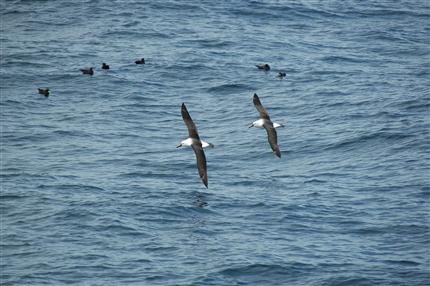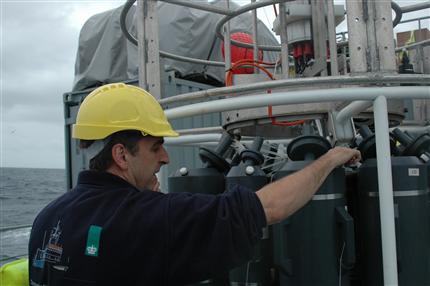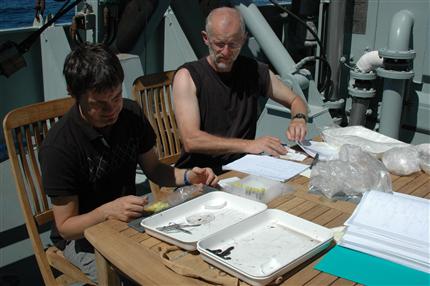From the Indian Ocean Newsletter 12
Dato 27.10.2006
VÆDDEREN’s position is out in the Indian Ocean, in an oceanic current which brings warm water from the north to meet cold water from the south. This affects temperatures both on board ship and in the sea. Samples that researchers bring up can contain animals from polar regions in one cast, and tropical sea creatures in the very next.
27.10.2006
More can be found in Danish on the web pages of ‘Politiken’, including the errant sea turtle which seems to have strayed from its normal latitudes.

Photograph: Ole Schou Hansen
October 2006. Atlantic yellow-nosed albatross (in the air) and petrels (on the water) in the Indian Ocean.
Changeable weather marked the first days after sailing from Cape Town, but during the weekend the sea was calmer, so that samples could be taken and most of the expedition members suffering from sea-sickness managed to get up. The first CTD cast of this leg was carried out on Saturday. Nets were in use, including the multinet which like the CTD profiler can be opened and shut during a cast to trap samples from varying depths of water.

Photograph: Ole Schou Hansen
The CTD profiler being prepared
Focus on the copepod
The analysis procedures which follow a cast are time-consuming and scientists are fully occupied in the time in between taking the samples. The ship’s hangar is now crowded with research equipment and is a kind of open laboratory. The petri dishes under the microscope contain amongst other things copepods and their excrement, which are being studied. The faecal pellets contain carbon. They sink down through the water column, thus bringing carbon to the deep sea. A deeper knowledge of copepod faeces will lead to improved understanding of the marine carbon cycle.

Photograph: Ole Schou Hansen
Ready for the study of copepod faecal samples!
To see a video clip on copepod research, click here. (Morgenavisen Jyllands-Postens home page, www.galathea.nu).
Sucking Cells
In a petri dish under another microscope one celled algae are in the spotlight. Niels Daugbjergs research team is monitoring them closely, even to the point of sucking the cells of algae up. The researchers are hoping to establish new groups by studying the genetic materials of the cells. Link to project description (Danish)
Deep-sea sushi in the night
Other, somewhat larger fish are being hunted, usually in the evening. This past week the trawl net has been cast to a depth of 350-400 metres. Amongst the catch was the so-called ‘silver axe’ (Argyropelecus olfersi) or hatchet fish. Its bladder had risen to the mouth because of the difference in pressure which occurs when the net is brought up quickly. A cuttle fish and lots of red shrimps were caught at the same time. Expedition leader Torkel Gissel Nielsen ate the prawns raw. Fresh sushi straight from the ocean…

Photograph: Ole Schou Hansen
The catch is dissected and classified.
Latest news…
The ship is still within cool latitudes, but she is gradually approaching warmer seas. Last update from the ship on Friday afternoon was to say that researchers are hard at work in the container laboratories, processing the day’s 400metre CTD cast samples.
Print page
|